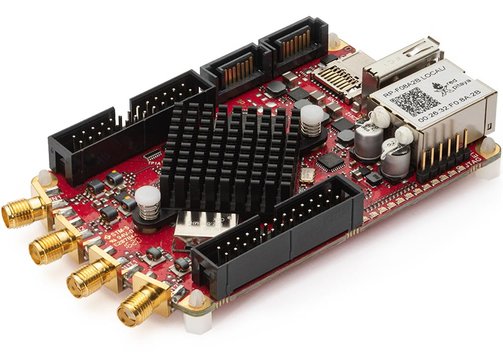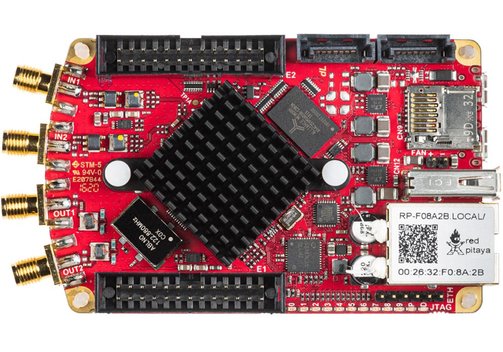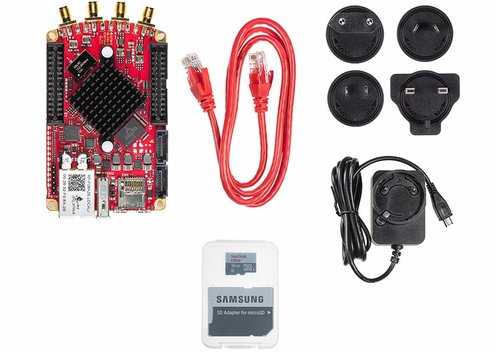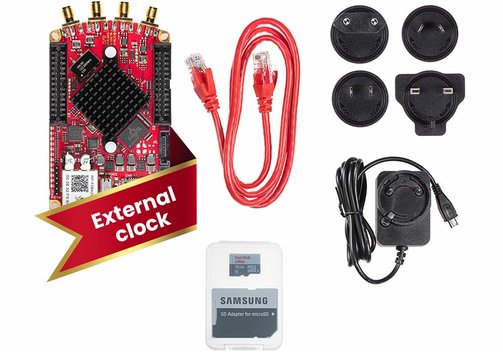Red Pitaya SDRlab 122-16 SoC RF and Radio T&M Platform
No longer in the product range. Last models available from stock.
Advantages of the SDRlab 122-16 Embedded T&M Module for Advanced RF Applications
- Compact, open and flexibly programmable.
- Optimized for HPSDR and more demanding RF applications.
- Extensive I/O and interface features, including LAN/Ethernet.
Red Pitaya SDRlab 122-16 SoC RF and Radio T&M Platform
The RedPitaya SDRlab 122-16 is specifically designed for HPSDR (High Performance Software Defined Radio) and more demanding RF applications. The module features two 16-bit, 50-Ω inputs and 14-bit, 50-Ω outputs. A Xilinx Zynq 7020 FPGA allows real-time processing capabilities, and the module also offers a 122.88-MHz clock with ultra-low phase noise. RF inputs are optimized for minimal distortion, noise and crosstalk, which significantly improves reception and expands antenna choices.
- Compact SoC measurement and test platform for capturing and generating RF signals.
- Ethernet interface.
- Xilinx SoC (CPU and FPGA).
- Two fast analog inputs and two outputs.
- 122.88 MHz clock with ultra-low noise.
- Possibility of integration into own system/product.
- Open software source code available.
- Works with a Linux or Windows PC.
- ▸Free online applications: Oscilloscope and signal-generator, spectrum- and logic-analyzer, SDR.
- Can be controlled remotely with LabVIEW, MATLAB, Python or Scilab.
- Can be programmed for custom requirements.
- An app marketplace with several free ▸apps is available.
Model Overview
| Model | SDRlab 122-16 | |||
| Processor | Dual-Core ARM Cortex-A9 MPCore | |||
| FPGA | Xilinx Zynq 7020 | |||
| RAM | 512 MB (4 Gb) | |||
| System memory | Micro-SD up to 32 GB | |||
| Interfaces | Ethernet 1 Gbit USB 2.0 Wi-Fi using Wi-Fi dongle | |||
| RF inputs | ||||
| Channels | 2 | |||
| Sample rate | 122.88 MS/s | |||
| ADC resolution | 16 bit | |||
| Full scale voltage range | 0.5 Vpp/-2 dBm | |||
| Input coupling | AC | |||
| Bandwidth | 300 kHz...550 MHz | |||
| Input impedance | 50 Ω | |||
| RS outputs | ||||
| Channels | 2 | |||
| Sample rate | 122.8 MS/s | |||
| DAC resolution | 14 bit | |||
| Full scale voltage range | ±0.5 V/+4 dBm | |||
| Load impedance | 50 Ω | |||
| Shortcut protection | - (RF transformer and AC coupled) | |||
| Typical rising/falling time | - | |||
| Bandwidth | 300 kHz...60 MHz | |||
| Extension connector | ||||
| Digital I/Os | 16 | |||
| Analog inputs | 4 channels, 0...3.5 V, 12 bit | |||
| Analog outputs | 4 channels, 0...1.8 V, 12 bit | |||
| Communication interfaces | I2C, UART, SPI | |||
| Available voltages | +5 V, +3.3 V, -4 V | |||
| Synchronization | Trigger input through extension connector; daisy chain connection over SATA connection | |||
| Kits | ||||
| Standard Kit | Red Pitaya SDRlab 122-16 board SD-card (16 GB, class 10) Ethernet cable (1 m) power supply (5 V/2 A) Tailored for SDR and other RF applications, HF and 50 MHz bands. No DC coupling! Minimum RF input frequency (-3 dB): 300 kHz. Comes with two 16 bit ADCs 50 Ω inputs; 14 bit DACs 50 Ω outputs. Three times bigger dual core ARM Cortex A9 and Xilinx Zynq 7020 FPGA. Bigger FPGA provides more real-time processing capabilities. Hardware compatible with HPSDR. Improved distortions, dynamic range, sensitivity, nois, and crosstalk | |||
| External Clock Standard Kit | Red Pitaya SDRlab 122-16 board, modified to be used with an external clock oscillator. CAUTION: This board needs an external clock signal 122.88 MHz in order to boot and function! SD-card (16 GB, class 10) Ethernet cable (1 m) power supply (5 V/2 A) Tailored for SDR and other RF applications, HF and 50 MHz bands. No DC coupling! Minimum RF input frequency (-3 dB): 300 kHz. Comes with two 16 bit ADCs 50 Ω inputs; 14 bit DACs 50 Ω outputs. Three times bigger dual core ARM Cortex A9 and Xilinx Zynq 7020 FPGA. Bigger FPGA provides more real-time processing capabilities. Hardware compatible with HPSDR. Improved distortions, dynamic range, sensitivity, noise, and crosstalk | |||
Information on product safety:
Manufacturer:
Red Pitaya, Velika pot 21, 5250 Solkan/SVN
www.redpitaya.com
Customers also bought
Last seen




































